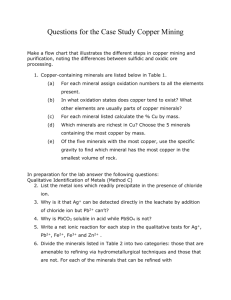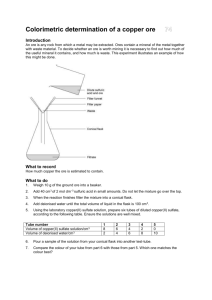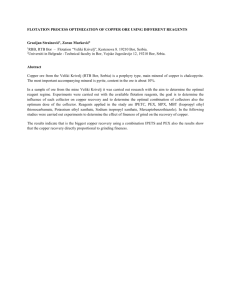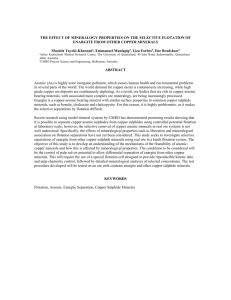Developing Ideas
advertisement
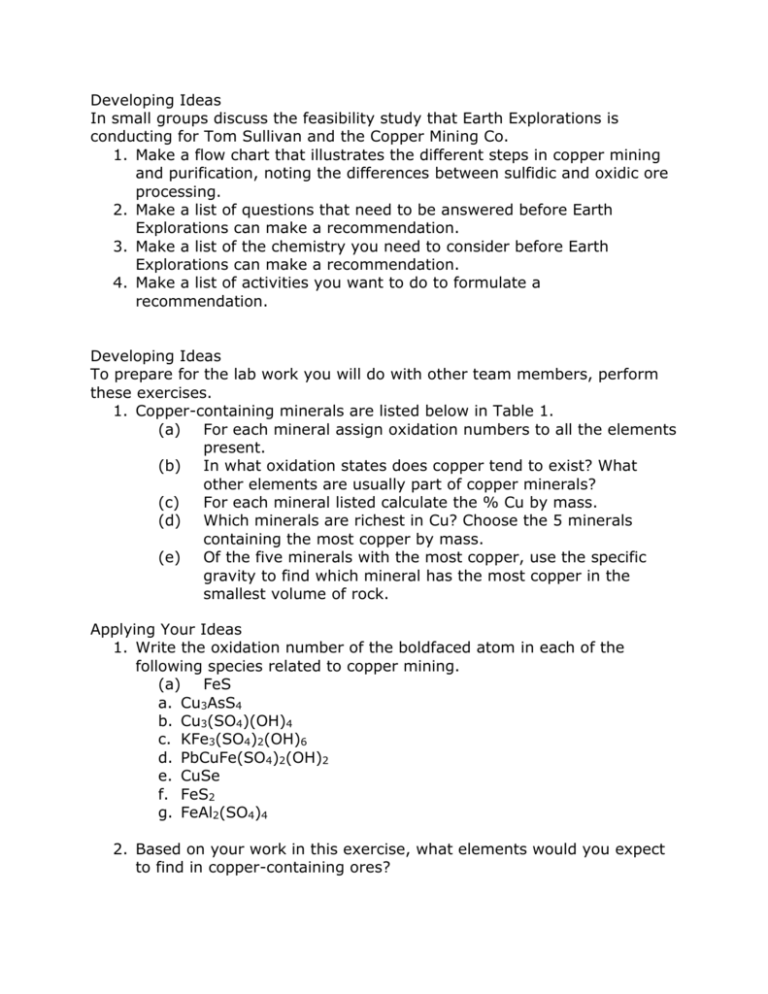
Developing Ideas In small groups discuss the feasibility study that Earth Explorations is conducting for Tom Sullivan and the Copper Mining Co. 1. Make a flow chart that illustrates the different steps in copper mining and purification, noting the differences between sulfidic and oxidic ore processing. 2. Make a list of questions that need to be answered before Earth Explorations can make a recommendation. 3. Make a list of the chemistry you need to consider before Earth Explorations can make a recommendation. 4. Make a list of activities you want to do to formulate a recommendation. Developing Ideas To prepare for the lab work you will do with other team members, perform these exercises. 1. Copper-containing minerals are listed below in Table 1. (a) For each mineral assign oxidation numbers to all the elements present. (b) In what oxidation states does copper tend to exist? What other elements are usually part of copper minerals? (c) For each mineral listed calculate the % Cu by mass. (d) Which minerals are richest in Cu? Choose the 5 minerals containing the most copper by mass. (e) Of the five minerals with the most copper, use the specific gravity to find which mineral has the most copper in the smallest volume of rock. Applying Your Ideas 1. Write the oxidation number of the boldfaced atom in each of the following species related to copper mining. (a) FeS a. Cu3AsS4 b. Cu3(SO4)(OH)4 c. KFe3(SO4)2(OH)6 d. PbCuFe(SO4)2(OH)2 e. CuSe f. FeS2 g. FeAl2(SO4)4 2. Based on your work in this exercise, what elements would you expect to find in copper-containing ores? 3. Based on the copper-containing minerals you expect to find in a copper ore deposit, what redox processes must occur before a salable copper metal product is obtained? Preparing for Inquiry The tests for Fe, Zn, Pb and Ag are qualitative analysis tests. Details are given in Appendix A. In preparation for the lab answer the following questions: Qualitative Identification of Metals (Method C) 1. List the metal ions which readily precipitate in the presence of chloride ion. 2. Why is it that Ag+ can be detected directly in the leachate by addition of chloride ion but Pb2+ can’t? 3. Compare the solubility product for PbSO4 and PbCO3. Why is PbCO3 soluble in acid while PbSO4 is not? 4. How Much Is the Land Worth? 11 5. Write a net ionic reaction for each step in the qualitative tests for Ag+, Pb2+, Fe2+, Fe3+ and Zn2+ . Developing Ideas 1. What other metals are present in the ore? 2. What handling procedures or precautions, especially environmental ones, should be taken by the Copper Mining Co. if they develop this ore body? 3. Does Tom Sullivan have any bargaining power to increase the profit he stands to make if he sells off his land? Explain. Developing Ideas Now that you have an idea of the requirements for profitable mining we would like to act as Tom’s consultants and assess what profit margins the mining company can achieve and whether Tom is being offered a fair price for his land. 1. In small groups discuss all the expenses that the company might incur. One way to do this is to start at one point and rotate around the group, each person writing down an idea and describing it to the others. Continue until all the ideas have been exhausted and you have a substantial list. 2. Collect and group all the ideas into broad categories that you think the mining company might use to provide an annual report to their shareholders. Be sure that all group members are included in the discussion and consensus on category titles is reached. 3. Each group presents and defends their categories before the whole class with the goal of generating a consensus among the whole class about the expense categories. We are now ready to begin looking at some data. 4. Your instructor will provide you with either tables of data or the internet addresses for several on-line sites that list the individual mining expenses and equipment requirements for a typical mine. Your job is to use the discussion and data to generate an expense report for the land. If you know the potential reserves of Tom’s land then you can calculate how much the copper must sell for if the mine is to break even. 5. Use the copper prices you obtained in Exploration 2D to determine how much copper the mining company must recover in order to equal the total mining expenses incurred for the period. If you have already calculated the operating costs you can use this value to determine any profit or loss for the mining company and estimate whether you feel Tom is being offered a fair price for his land. 1. Divide the minerals listed in Table 2 into two categories: those that are amenable to refining via pyrometallurgical techniques and those that are not. For each of the minerals that can be refined with pyrometallurgy, calculate the amount of copper, in grams, that could be recovered from 1 ton of the pure mineral. 2. Calculate also the volume of oxygen gas at 1 atmosphere pressure necessary to convert 1 ton of ore containing 1.25% Cu in the form of chalococite to native copper. 3. Using the values in Appendix B, calculate ∆H for this process. 4. (a) The Nifty Copper Operation run by WMC in their 1996 - 1997 season milled 0.705 million tons of ore using 313 Megajoules per ton of ore. Use the data you calculated in Session 2 about the amount of copper present in ores to determine the amount of energy required per kilogram of copper produced. 5. (b) Using table data determine the costs per kg Cu associated with pyrometallurgy. In this exploration, Earth Explorations examines the efficiency of leaching ore samples from Tom Sullivan’s land. Answer these questions in preparation for the laboratory: 1. What is the molarity of H2SO4 to be used in the leachate? Express this concentration in g H2SO4 per L. In kg H2SO4 per m3. 2. What advantages might there be to using a small volume of leachate per amount of ore? A large volume? 3. What type of leachate mixing will be used in the study? Explain your choice. 4. What is the maximum possible concentrations of Cu2+ that could be obtained in the intended volume of leachate? 5. What is the optimal pH for bacterial assisted leaching of ore? What pH is best for nonbiotic leaching? What pH range will you attempt to maintain in your study? What could occur in the mixture if the pH were to deviate beyond this range? 6. How can biological activity in the leachate be estimated? 7. Does your ore contain any metals or components that might inhibit or deter bioleaching activity? Applying Your Ideas 1. Heap leaching is accomplished by piling broken pieces of ore in a large area and sprinkling it with dilute sulfuric acid solution, known in the industry as lixiviant. The solution trickles through the heap and runs down a sloped bed and is collected at the bottom in a pool. The initial lixiviant solution sprayed on the heap has the typical composition given below. The solution is recycled and therefore contains some copper prior to being applied to the heap. (b) For each species listed determine the concentration in molarity. (c) substance concentration (kg/m3) concentration (M) a. H2SO4 15 b. Cu2+ 0.1 c. Fe2+ 0.25 d. Fe3+ 2.25 2. The chemical reactions associated with leaching are described in words below. Write the net ionic chemical reaction that is described. (a) Non-sulfide copper ores are easily leached by sulfuric acid. For example, write a net ionic reaction for the leaching of Tenorite by H2SO4. (b) An ore body contains many different minerals. When H2SO4 acts on heaped ore that contains FeS2 (pyrite) the sulfur is oxidized by oxygen from the air. (c) In the presence of atmospheric oxygen aqueous Fe2+ is readily oxidized to Fe3+. (d) The Fe3+ thus generated can act as an oxidizing agent to oxidize secondary copper sulfide minerals. Use CuS as an example. 3. Get an estimate of the size of a heap compare the following information about a heap in Arizona to the size of your school’s science building. A “lift” is a pile of rock that is leached for 1-4 months. After that time another “lift” is added on top of the original lift and that new ore is leached. While the new lift is being leached the old lift continues to see lixivant solution after it trickles through the new lift. i. lift height 3 m ii. maximum number of lifts in a heap 25 iii. area per heap 12000 m2 iv. total area under leach 2x105 m2 (a) How does the area of the heap compare with the “footprint” your science center makes on your campus? (b) How high is a fully developed heap? (c) How does this three-dimensional heap compare with the threedimensional building? 4. List the environmental and economic considerations in hydrometallurgical processing. 5. Using the data provided on the costs of extracting copper (See Appendix D), estimate the total cost per kg to produce copper metal.
